Cognitive Development Stages in Virtual Children: A Detailed Report
VerifiedAdded on 2022/09/26
|8
|2184
|34
Report
AI Summary
This report examines the cognitive development of two virtual children, Kevin and Ryuby, through different stages, from infancy to adulthood. The author applies Piaget's cognitive theory framework to analyze the observed changes in social, cognitive, and physical domains. The report details the characteristics of each stage, including the sensorimotor, preoperational, concrete operational, and formal operational stages. It highlights how the virtual children acquired knowledge, developed language skills, and demonstrated logical thinking. The report also discusses the impact of these developmental changes on their decision-making, social interactions, and future goals. The author reflects on the challenges and rewards of raising virtual children, emphasizing the importance of understanding developmental milestones. The report includes references to relevant literature on child development, and the author highlights the importance of research in understanding child behavior.
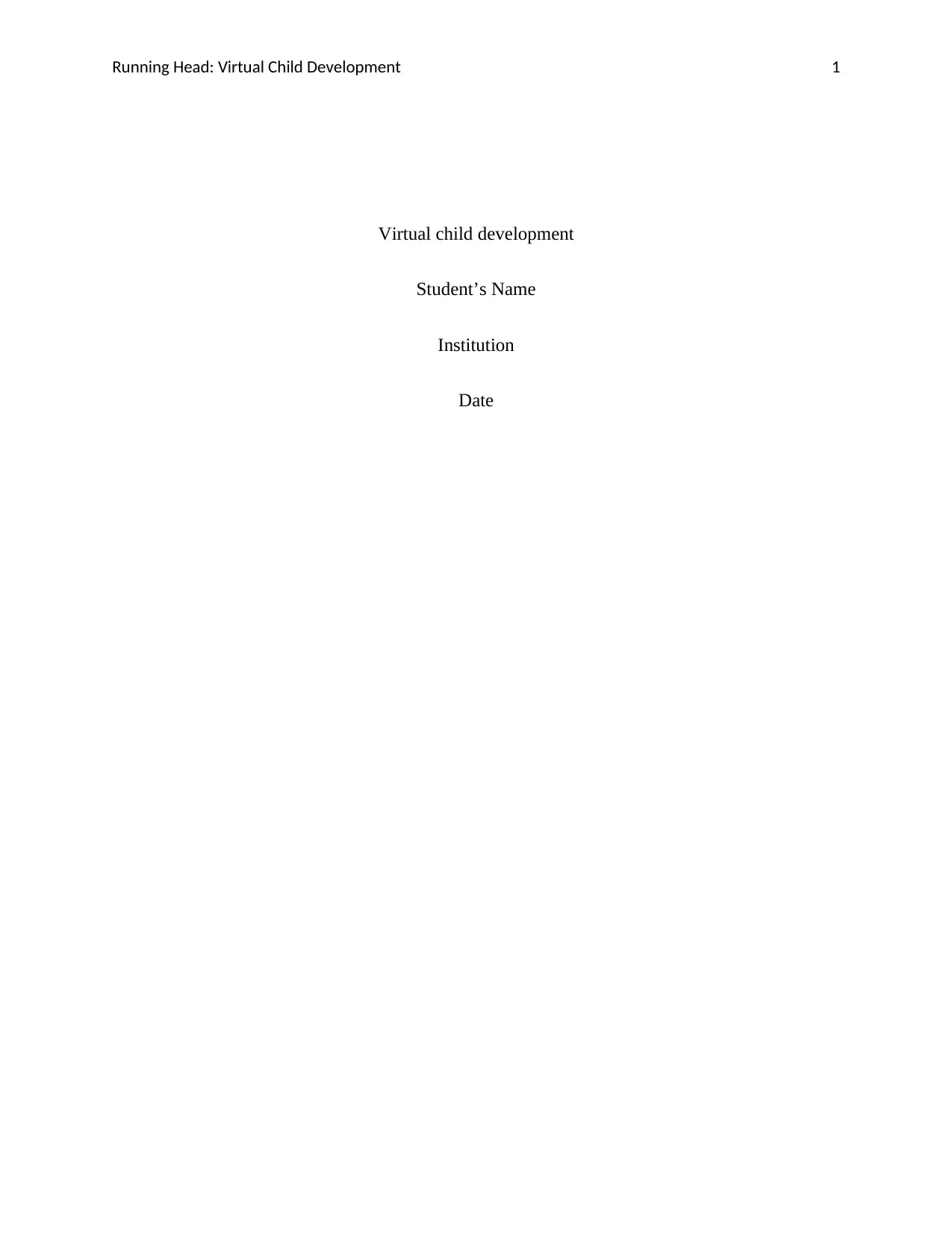
Running Head: Virtual Child Development 1
Virtual child development
Student’s Name
Institution
Date
Virtual child development
Student’s Name
Institution
Date
Paraphrase This Document
Need a fresh take? Get an instant paraphrase of this document with our AI Paraphraser
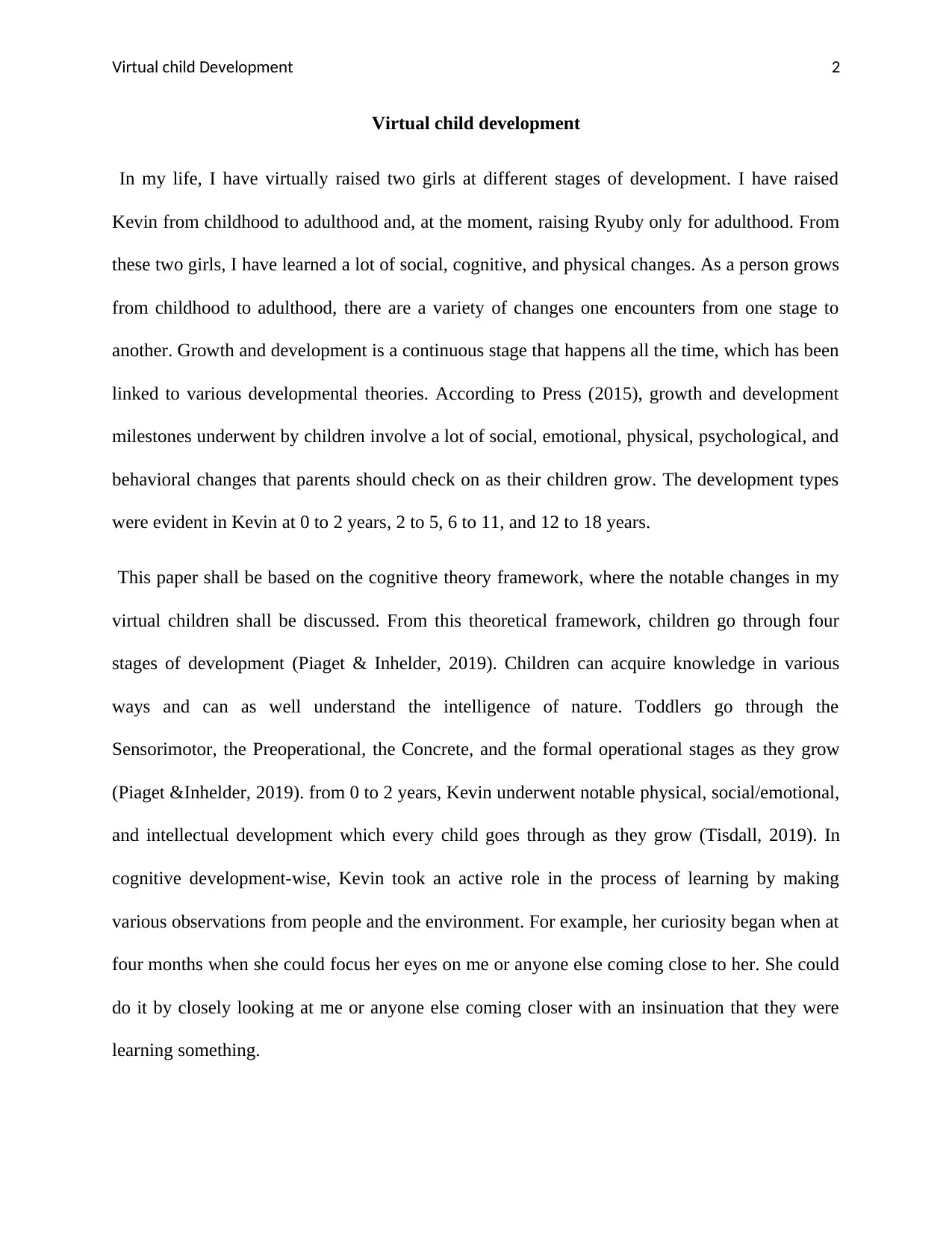
Virtual child Development 2
Virtual child development
In my life, I have virtually raised two girls at different stages of development. I have raised
Kevin from childhood to adulthood and, at the moment, raising Ryuby only for adulthood. From
these two girls, I have learned a lot of social, cognitive, and physical changes. As a person grows
from childhood to adulthood, there are a variety of changes one encounters from one stage to
another. Growth and development is a continuous stage that happens all the time, which has been
linked to various developmental theories. According to Press (2015), growth and development
milestones underwent by children involve a lot of social, emotional, physical, psychological, and
behavioral changes that parents should check on as their children grow. The development types
were evident in Kevin at 0 to 2 years, 2 to 5, 6 to 11, and 12 to 18 years.
This paper shall be based on the cognitive theory framework, where the notable changes in my
virtual children shall be discussed. From this theoretical framework, children go through four
stages of development (Piaget & Inhelder, 2019). Children can acquire knowledge in various
ways and can as well understand the intelligence of nature. Toddlers go through the
Sensorimotor, the Preoperational, the Concrete, and the formal operational stages as they grow
(Piaget &Inhelder, 2019). from 0 to 2 years, Kevin underwent notable physical, social/emotional,
and intellectual development which every child goes through as they grow (Tisdall, 2019). In
cognitive development-wise, Kevin took an active role in the process of learning by making
various observations from people and the environment. For example, her curiosity began when at
four months when she could focus her eyes on me or anyone else coming close to her. She could
do it by closely looking at me or anyone else coming closer with an insinuation that they were
learning something.
Virtual child development
In my life, I have virtually raised two girls at different stages of development. I have raised
Kevin from childhood to adulthood and, at the moment, raising Ryuby only for adulthood. From
these two girls, I have learned a lot of social, cognitive, and physical changes. As a person grows
from childhood to adulthood, there are a variety of changes one encounters from one stage to
another. Growth and development is a continuous stage that happens all the time, which has been
linked to various developmental theories. According to Press (2015), growth and development
milestones underwent by children involve a lot of social, emotional, physical, psychological, and
behavioral changes that parents should check on as their children grow. The development types
were evident in Kevin at 0 to 2 years, 2 to 5, 6 to 11, and 12 to 18 years.
This paper shall be based on the cognitive theory framework, where the notable changes in my
virtual children shall be discussed. From this theoretical framework, children go through four
stages of development (Piaget & Inhelder, 2019). Children can acquire knowledge in various
ways and can as well understand the intelligence of nature. Toddlers go through the
Sensorimotor, the Preoperational, the Concrete, and the formal operational stages as they grow
(Piaget &Inhelder, 2019). from 0 to 2 years, Kevin underwent notable physical, social/emotional,
and intellectual development which every child goes through as they grow (Tisdall, 2019). In
cognitive development-wise, Kevin took an active role in the process of learning by making
various observations from people and the environment. For example, her curiosity began when at
four months when she could focus her eyes on me or anyone else coming close to her. She could
do it by closely looking at me or anyone else coming closer with an insinuation that they were
learning something.
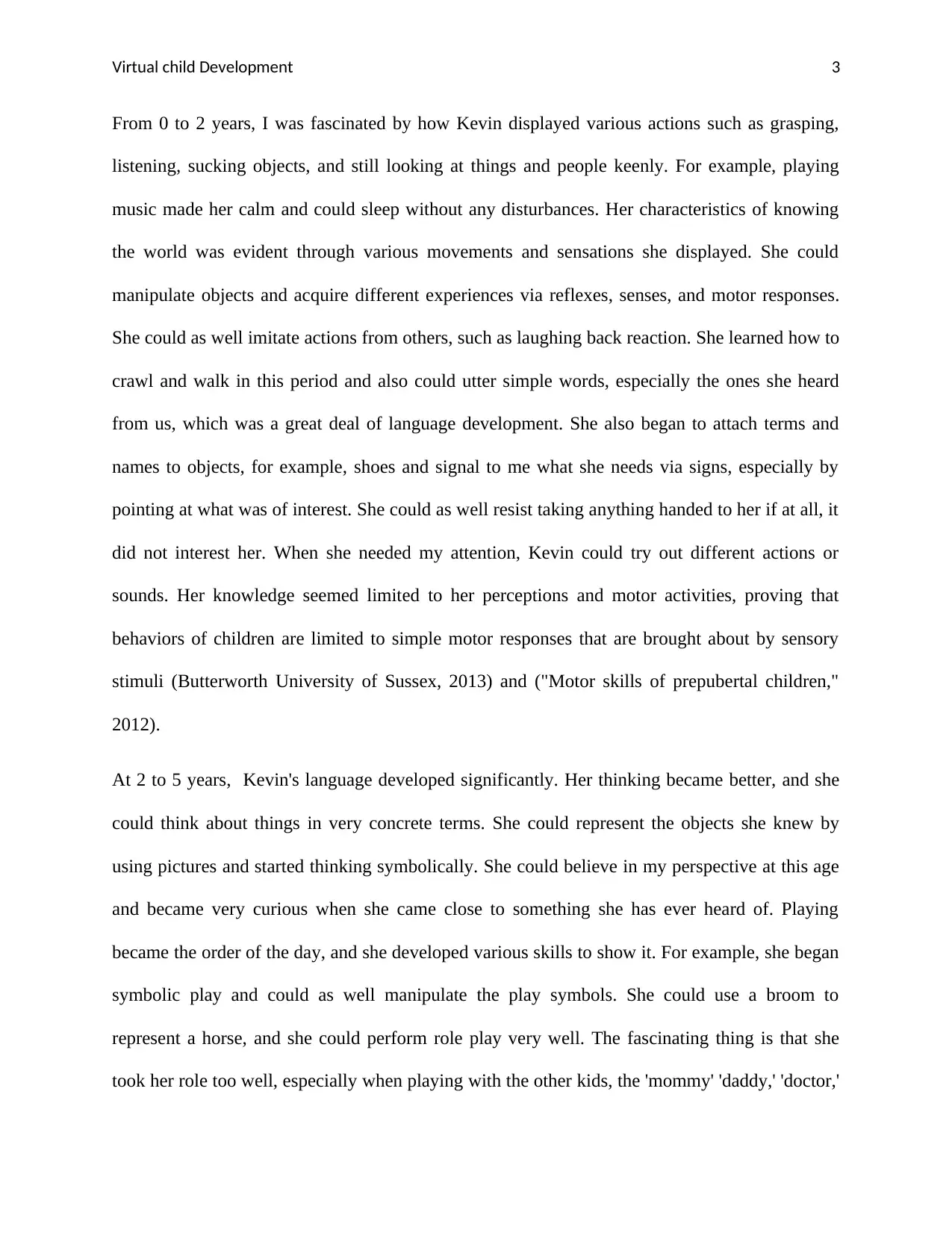
Virtual child Development 3
From 0 to 2 years, I was fascinated by how Kevin displayed various actions such as grasping,
listening, sucking objects, and still looking at things and people keenly. For example, playing
music made her calm and could sleep without any disturbances. Her characteristics of knowing
the world was evident through various movements and sensations she displayed. She could
manipulate objects and acquire different experiences via reflexes, senses, and motor responses.
She could as well imitate actions from others, such as laughing back reaction. She learned how to
crawl and walk in this period and also could utter simple words, especially the ones she heard
from us, which was a great deal of language development. She also began to attach terms and
names to objects, for example, shoes and signal to me what she needs via signs, especially by
pointing at what was of interest. She could as well resist taking anything handed to her if at all, it
did not interest her. When she needed my attention, Kevin could try out different actions or
sounds. Her knowledge seemed limited to her perceptions and motor activities, proving that
behaviors of children are limited to simple motor responses that are brought about by sensory
stimuli (Butterworth University of Sussex, 2013) and ("Motor skills of prepubertal children,"
2012).
At 2 to 5 years, Kevin's language developed significantly. Her thinking became better, and she
could think about things in very concrete terms. She could represent the objects she knew by
using pictures and started thinking symbolically. She could believe in my perspective at this age
and became very curious when she came close to something she has ever heard of. Playing
became the order of the day, and she developed various skills to show it. For example, she began
symbolic play and could as well manipulate the play symbols. She could use a broom to
represent a horse, and she could perform role play very well. The fascinating thing is that she
took her role too well, especially when playing with the other kids, the 'mommy' 'daddy,' 'doctor,'
From 0 to 2 years, I was fascinated by how Kevin displayed various actions such as grasping,
listening, sucking objects, and still looking at things and people keenly. For example, playing
music made her calm and could sleep without any disturbances. Her characteristics of knowing
the world was evident through various movements and sensations she displayed. She could
manipulate objects and acquire different experiences via reflexes, senses, and motor responses.
She could as well imitate actions from others, such as laughing back reaction. She learned how to
crawl and walk in this period and also could utter simple words, especially the ones she heard
from us, which was a great deal of language development. She also began to attach terms and
names to objects, for example, shoes and signal to me what she needs via signs, especially by
pointing at what was of interest. She could as well resist taking anything handed to her if at all, it
did not interest her. When she needed my attention, Kevin could try out different actions or
sounds. Her knowledge seemed limited to her perceptions and motor activities, proving that
behaviors of children are limited to simple motor responses that are brought about by sensory
stimuli (Butterworth University of Sussex, 2013) and ("Motor skills of prepubertal children,"
2012).
At 2 to 5 years, Kevin's language developed significantly. Her thinking became better, and she
could think about things in very concrete terms. She could represent the objects she knew by
using pictures and started thinking symbolically. She could believe in my perspective at this age
and became very curious when she came close to something she has ever heard of. Playing
became the order of the day, and she developed various skills to show it. For example, she began
symbolic play and could as well manipulate the play symbols. She could use a broom to
represent a horse, and she could perform role play very well. The fascinating thing is that she
took her role too well, especially when playing with the other kids, the 'mommy' 'daddy,' 'doctor,'
⊘ This is a preview!⊘
Do you want full access?
Subscribe today to unlock all pages.

Trusted by 1+ million students worldwide

Virtual child Development 4
and other characters as they played. She could imitate, for example, their teachers' walking style
and how she talks. My virtual child could easily give her point of view on something and it took
too long to look at things from another person's perspective. At the age of seven, she could
understand things differently in different situations and different points of view, which showed
that she was becoming more egocentric.
At 6 to 11 years, Kevin started becoming more logical in her thinking, especially on concrete
events, and could understand scientific demonstrations. For example, when she could be given
equal amounts of drinks from differently shaped cups, she could choose any because she
logically knew that the shape did not matter and thus could choose either a skinny or tall glass.
Her thinking on issues was now very concrete, logical, and organized. She started thinking of
other people's perceptions about a situation. She thought from inductive logic, and reason from
specific information to the general principle as it happens in most of the people today (Blyden,
2012). This technique of thinking enabled Kevin to successfully tackle mathematical problems
from their classroom and get the right answers. She could also use their science class concepts to
analyze the daily happenings in the environment. For example, I remember her using a flower
next to our door for understanding cross-pollination. Kevin completely understood that people
have different thoughts on issues and happenings, which were unique to them. She also realized
that people could choose to share their ideas, feeling, views, and opinions or not. Kevin could
easily seek information about something that did not work out. For example, she planted seeds to
test germination, and when the seeds failed to grow well, she came to me to enquire what could
have gone wrong.
From 12 to 18 years, a lot happened to Kevin. She went through a lot of cognitive development,
where she could think of hypothetical problems and show abstract thoughts (Schlesinger &
and other characters as they played. She could imitate, for example, their teachers' walking style
and how she talks. My virtual child could easily give her point of view on something and it took
too long to look at things from another person's perspective. At the age of seven, she could
understand things differently in different situations and different points of view, which showed
that she was becoming more egocentric.
At 6 to 11 years, Kevin started becoming more logical in her thinking, especially on concrete
events, and could understand scientific demonstrations. For example, when she could be given
equal amounts of drinks from differently shaped cups, she could choose any because she
logically knew that the shape did not matter and thus could choose either a skinny or tall glass.
Her thinking on issues was now very concrete, logical, and organized. She started thinking of
other people's perceptions about a situation. She thought from inductive logic, and reason from
specific information to the general principle as it happens in most of the people today (Blyden,
2012). This technique of thinking enabled Kevin to successfully tackle mathematical problems
from their classroom and get the right answers. She could also use their science class concepts to
analyze the daily happenings in the environment. For example, I remember her using a flower
next to our door for understanding cross-pollination. Kevin completely understood that people
have different thoughts on issues and happenings, which were unique to them. She also realized
that people could choose to share their ideas, feeling, views, and opinions or not. Kevin could
easily seek information about something that did not work out. For example, she planted seeds to
test germination, and when the seeds failed to grow well, she came to me to enquire what could
have gone wrong.
From 12 to 18 years, a lot happened to Kevin. She went through a lot of cognitive development,
where she could think of hypothetical problems and show abstract thoughts (Schlesinger &
Paraphrase This Document
Need a fresh take? Get an instant paraphrase of this document with our AI Paraphraser
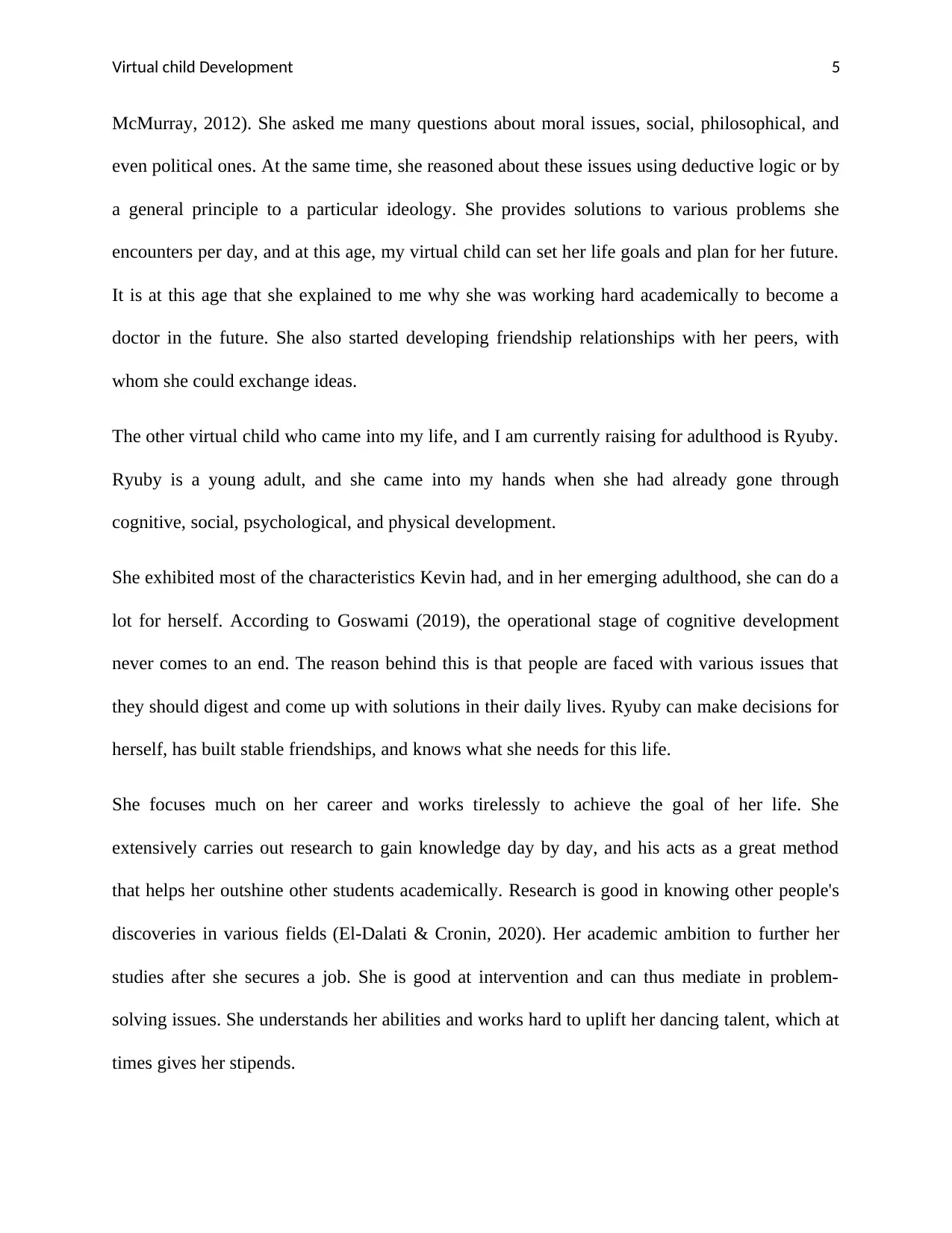
Virtual child Development 5
McMurray, 2012). She asked me many questions about moral issues, social, philosophical, and
even political ones. At the same time, she reasoned about these issues using deductive logic or by
a general principle to a particular ideology. She provides solutions to various problems she
encounters per day, and at this age, my virtual child can set her life goals and plan for her future.
It is at this age that she explained to me why she was working hard academically to become a
doctor in the future. She also started developing friendship relationships with her peers, with
whom she could exchange ideas.
The other virtual child who came into my life, and I am currently raising for adulthood is Ryuby.
Ryuby is a young adult, and she came into my hands when she had already gone through
cognitive, social, psychological, and physical development.
She exhibited most of the characteristics Kevin had, and in her emerging adulthood, she can do a
lot for herself. According to Goswami (2019), the operational stage of cognitive development
never comes to an end. The reason behind this is that people are faced with various issues that
they should digest and come up with solutions in their daily lives. Ryuby can make decisions for
herself, has built stable friendships, and knows what she needs for this life.
She focuses much on her career and works tirelessly to achieve the goal of her life. She
extensively carries out research to gain knowledge day by day, and his acts as a great method
that helps her outshine other students academically. Research is good in knowing other people's
discoveries in various fields (El-Dalati & Cronin, 2020). Her academic ambition to further her
studies after she secures a job. She is good at intervention and can thus mediate in problem-
solving issues. She understands her abilities and works hard to uplift her dancing talent, which at
times gives her stipends.
McMurray, 2012). She asked me many questions about moral issues, social, philosophical, and
even political ones. At the same time, she reasoned about these issues using deductive logic or by
a general principle to a particular ideology. She provides solutions to various problems she
encounters per day, and at this age, my virtual child can set her life goals and plan for her future.
It is at this age that she explained to me why she was working hard academically to become a
doctor in the future. She also started developing friendship relationships with her peers, with
whom she could exchange ideas.
The other virtual child who came into my life, and I am currently raising for adulthood is Ryuby.
Ryuby is a young adult, and she came into my hands when she had already gone through
cognitive, social, psychological, and physical development.
She exhibited most of the characteristics Kevin had, and in her emerging adulthood, she can do a
lot for herself. According to Goswami (2019), the operational stage of cognitive development
never comes to an end. The reason behind this is that people are faced with various issues that
they should digest and come up with solutions in their daily lives. Ryuby can make decisions for
herself, has built stable friendships, and knows what she needs for this life.
She focuses much on her career and works tirelessly to achieve the goal of her life. She
extensively carries out research to gain knowledge day by day, and his acts as a great method
that helps her outshine other students academically. Research is good in knowing other people's
discoveries in various fields (El-Dalati & Cronin, 2020). Her academic ambition to further her
studies after she secures a job. She is good at intervention and can thus mediate in problem-
solving issues. She understands her abilities and works hard to uplift her dancing talent, which at
times gives her stipends.
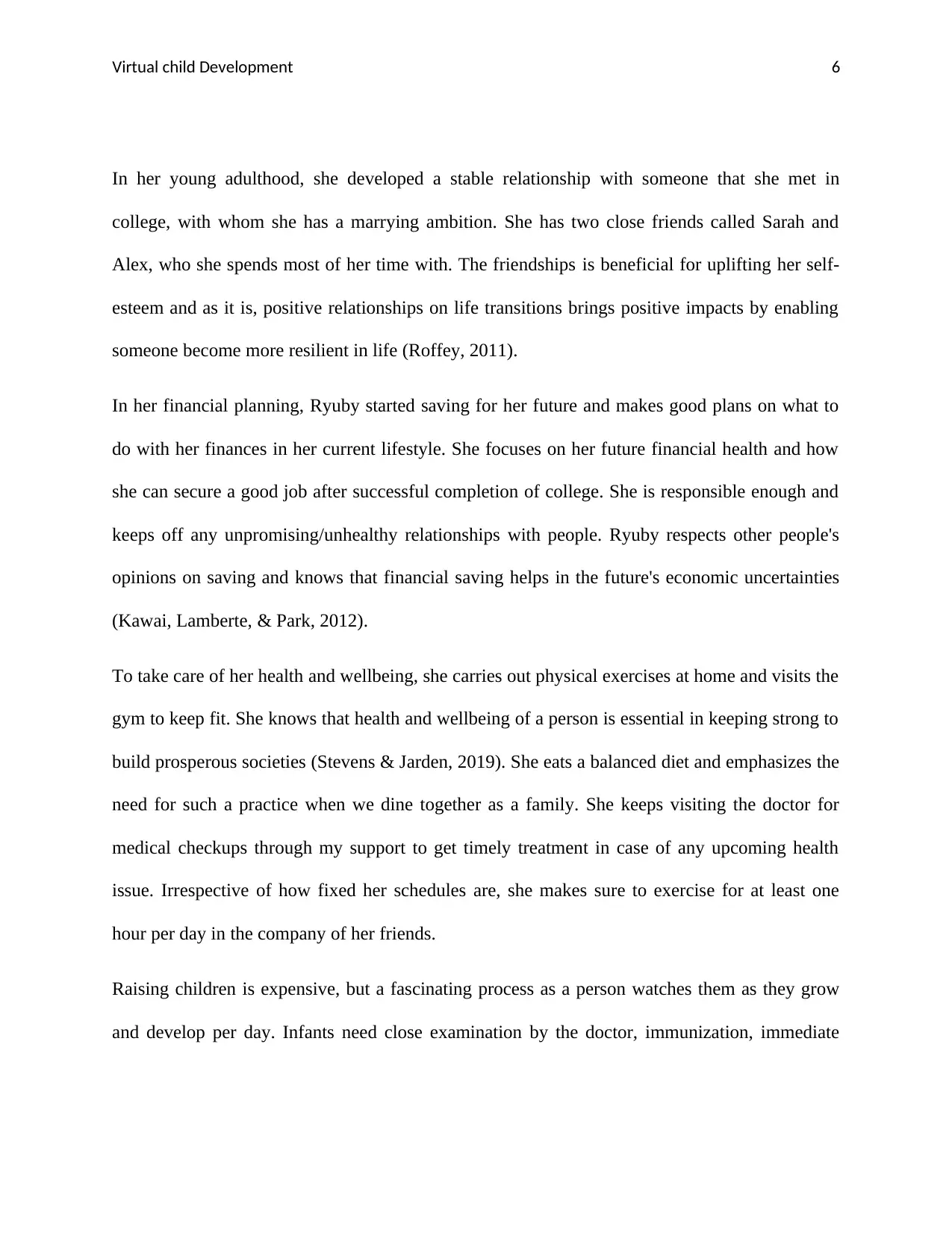
Virtual child Development 6
In her young adulthood, she developed a stable relationship with someone that she met in
college, with whom she has a marrying ambition. She has two close friends called Sarah and
Alex, who she spends most of her time with. The friendships is beneficial for uplifting her self-
esteem and as it is, positive relationships on life transitions brings positive impacts by enabling
someone become more resilient in life (Roffey, 2011).
In her financial planning, Ryuby started saving for her future and makes good plans on what to
do with her finances in her current lifestyle. She focuses on her future financial health and how
she can secure a good job after successful completion of college. She is responsible enough and
keeps off any unpromising/unhealthy relationships with people. Ryuby respects other people's
opinions on saving and knows that financial saving helps in the future's economic uncertainties
(Kawai, Lamberte, & Park, 2012).
To take care of her health and wellbeing, she carries out physical exercises at home and visits the
gym to keep fit. She knows that health and wellbeing of a person is essential in keeping strong to
build prosperous societies (Stevens & Jarden, 2019). She eats a balanced diet and emphasizes the
need for such a practice when we dine together as a family. She keeps visiting the doctor for
medical checkups through my support to get timely treatment in case of any upcoming health
issue. Irrespective of how fixed her schedules are, she makes sure to exercise for at least one
hour per day in the company of her friends.
Raising children is expensive, but a fascinating process as a person watches them as they grow
and develop per day. Infants need close examination by the doctor, immunization, immediate
In her young adulthood, she developed a stable relationship with someone that she met in
college, with whom she has a marrying ambition. She has two close friends called Sarah and
Alex, who she spends most of her time with. The friendships is beneficial for uplifting her self-
esteem and as it is, positive relationships on life transitions brings positive impacts by enabling
someone become more resilient in life (Roffey, 2011).
In her financial planning, Ryuby started saving for her future and makes good plans on what to
do with her finances in her current lifestyle. She focuses on her future financial health and how
she can secure a good job after successful completion of college. She is responsible enough and
keeps off any unpromising/unhealthy relationships with people. Ryuby respects other people's
opinions on saving and knows that financial saving helps in the future's economic uncertainties
(Kawai, Lamberte, & Park, 2012).
To take care of her health and wellbeing, she carries out physical exercises at home and visits the
gym to keep fit. She knows that health and wellbeing of a person is essential in keeping strong to
build prosperous societies (Stevens & Jarden, 2019). She eats a balanced diet and emphasizes the
need for such a practice when we dine together as a family. She keeps visiting the doctor for
medical checkups through my support to get timely treatment in case of any upcoming health
issue. Irrespective of how fixed her schedules are, she makes sure to exercise for at least one
hour per day in the company of her friends.
Raising children is expensive, but a fascinating process as a person watches them as they grow
and develop per day. Infants need close examination by the doctor, immunization, immediate
⊘ This is a preview!⊘
Do you want full access?
Subscribe today to unlock all pages.

Trusted by 1+ million students worldwide
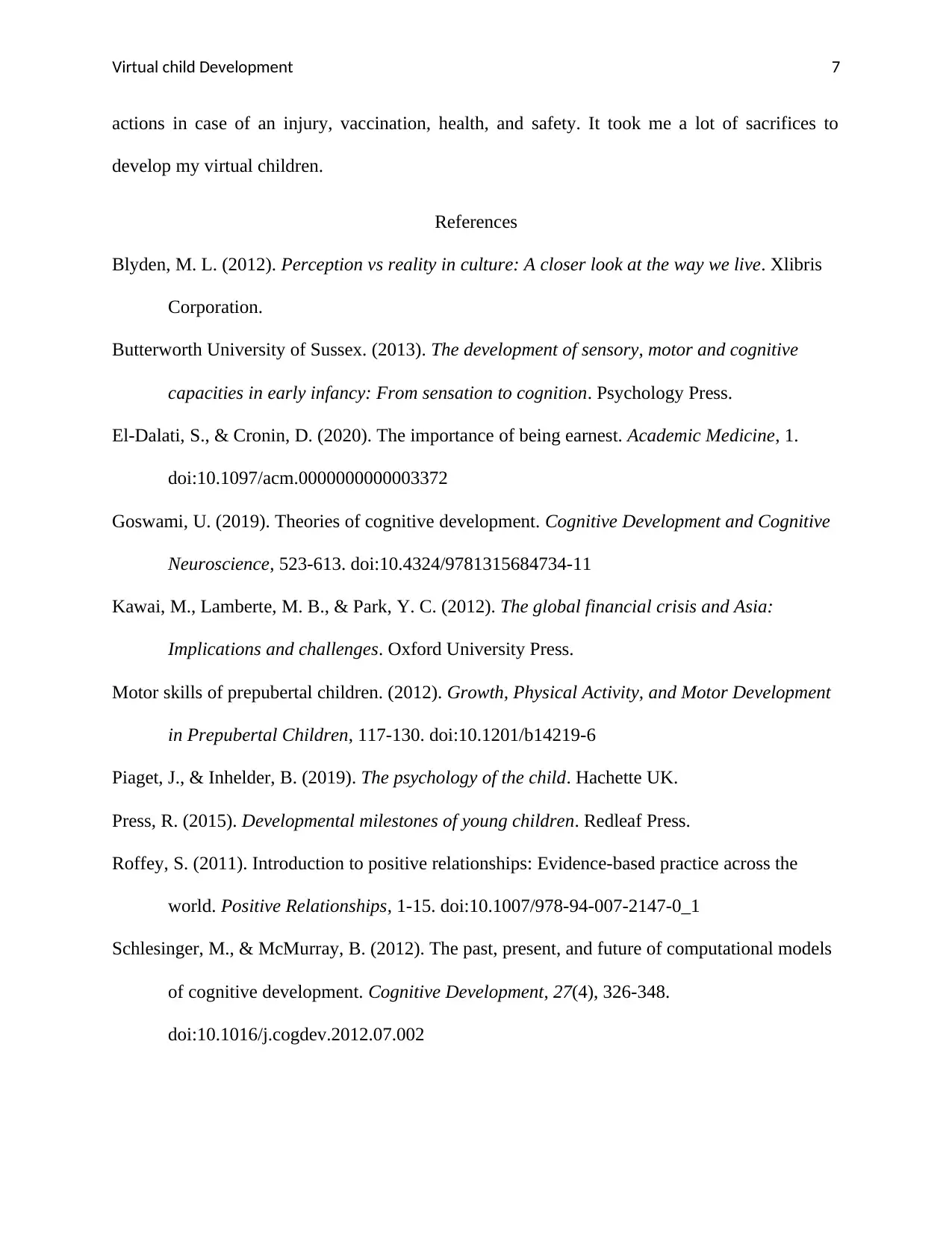
Virtual child Development 7
actions in case of an injury, vaccination, health, and safety. It took me a lot of sacrifices to
develop my virtual children.
References
Blyden, M. L. (2012). Perception vs reality in culture: A closer look at the way we live. Xlibris
Corporation.
Butterworth University of Sussex. (2013). The development of sensory, motor and cognitive
capacities in early infancy: From sensation to cognition. Psychology Press.
El-Dalati, S., & Cronin, D. (2020). The importance of being earnest. Academic Medicine, 1.
doi:10.1097/acm.0000000000003372
Goswami, U. (2019). Theories of cognitive development. Cognitive Development and Cognitive
Neuroscience, 523-613. doi:10.4324/9781315684734-11
Kawai, M., Lamberte, M. B., & Park, Y. C. (2012). The global financial crisis and Asia:
Implications and challenges. Oxford University Press.
Motor skills of prepubertal children. (2012). Growth, Physical Activity, and Motor Development
in Prepubertal Children, 117-130. doi:10.1201/b14219-6
Piaget, J., & Inhelder, B. (2019). The psychology of the child. Hachette UK.
Press, R. (2015). Developmental milestones of young children. Redleaf Press.
Roffey, S. (2011). Introduction to positive relationships: Evidence-based practice across the
world. Positive Relationships, 1-15. doi:10.1007/978-94-007-2147-0_1
Schlesinger, M., & McMurray, B. (2012). The past, present, and future of computational models
of cognitive development. Cognitive Development, 27(4), 326-348.
doi:10.1016/j.cogdev.2012.07.002
actions in case of an injury, vaccination, health, and safety. It took me a lot of sacrifices to
develop my virtual children.
References
Blyden, M. L. (2012). Perception vs reality in culture: A closer look at the way we live. Xlibris
Corporation.
Butterworth University of Sussex. (2013). The development of sensory, motor and cognitive
capacities in early infancy: From sensation to cognition. Psychology Press.
El-Dalati, S., & Cronin, D. (2020). The importance of being earnest. Academic Medicine, 1.
doi:10.1097/acm.0000000000003372
Goswami, U. (2019). Theories of cognitive development. Cognitive Development and Cognitive
Neuroscience, 523-613. doi:10.4324/9781315684734-11
Kawai, M., Lamberte, M. B., & Park, Y. C. (2012). The global financial crisis and Asia:
Implications and challenges. Oxford University Press.
Motor skills of prepubertal children. (2012). Growth, Physical Activity, and Motor Development
in Prepubertal Children, 117-130. doi:10.1201/b14219-6
Piaget, J., & Inhelder, B. (2019). The psychology of the child. Hachette UK.
Press, R. (2015). Developmental milestones of young children. Redleaf Press.
Roffey, S. (2011). Introduction to positive relationships: Evidence-based practice across the
world. Positive Relationships, 1-15. doi:10.1007/978-94-007-2147-0_1
Schlesinger, M., & McMurray, B. (2012). The past, present, and future of computational models
of cognitive development. Cognitive Development, 27(4), 326-348.
doi:10.1016/j.cogdev.2012.07.002
Paraphrase This Document
Need a fresh take? Get an instant paraphrase of this document with our AI Paraphraser
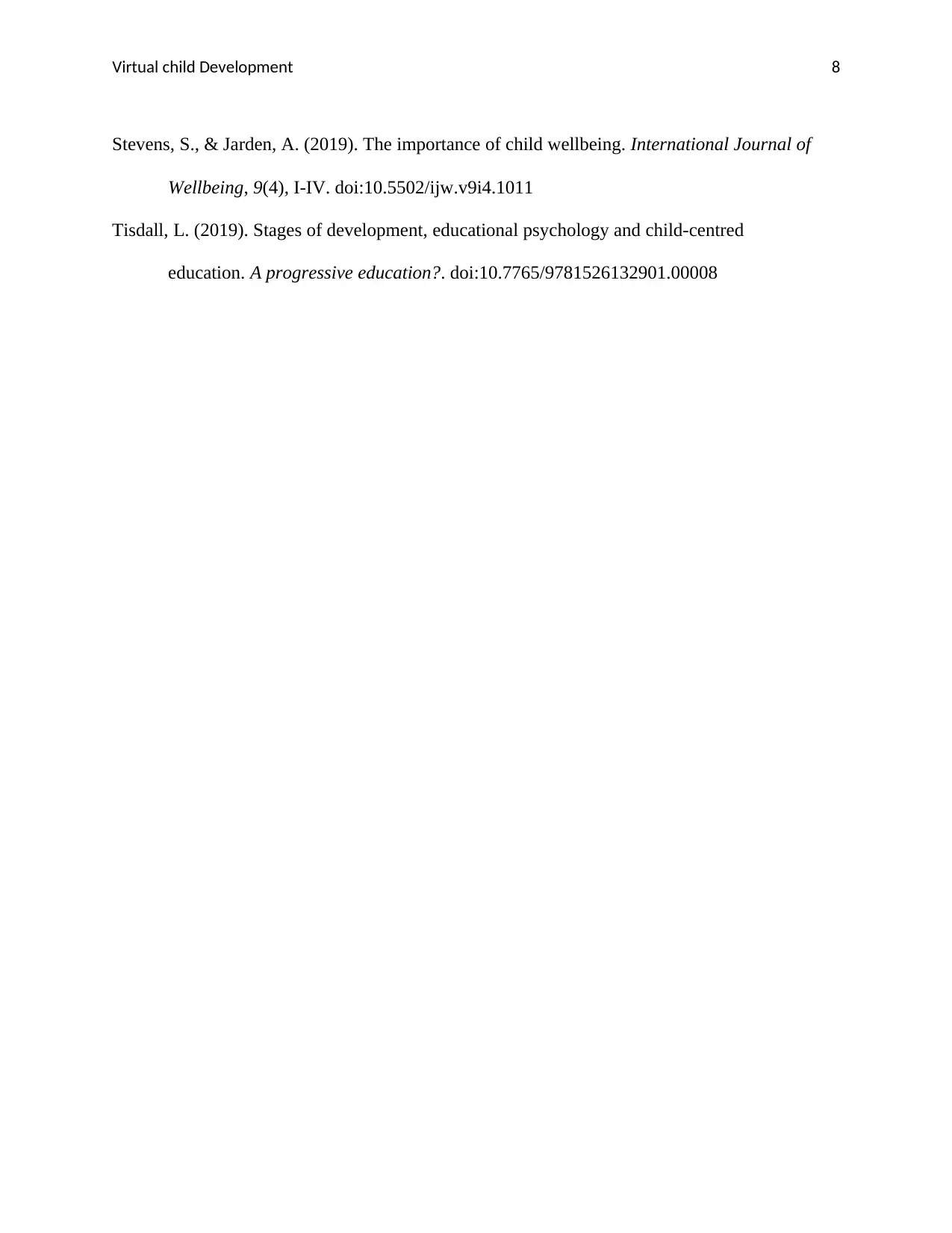
Virtual child Development 8
Stevens, S., & Jarden, A. (2019). The importance of child wellbeing. International Journal of
Wellbeing, 9(4), I-IV. doi:10.5502/ijw.v9i4.1011
Tisdall, L. (2019). Stages of development, educational psychology and child-centred
education. A progressive education?. doi:10.7765/9781526132901.00008
Stevens, S., & Jarden, A. (2019). The importance of child wellbeing. International Journal of
Wellbeing, 9(4), I-IV. doi:10.5502/ijw.v9i4.1011
Tisdall, L. (2019). Stages of development, educational psychology and child-centred
education. A progressive education?. doi:10.7765/9781526132901.00008
1 out of 8
Related Documents
Your All-in-One AI-Powered Toolkit for Academic Success.
+13062052269
info@desklib.com
Available 24*7 on WhatsApp / Email
![[object Object]](/_next/static/media/star-bottom.7253800d.svg)
Unlock your academic potential
Copyright © 2020–2025 A2Z Services. All Rights Reserved. Developed and managed by ZUCOL.





